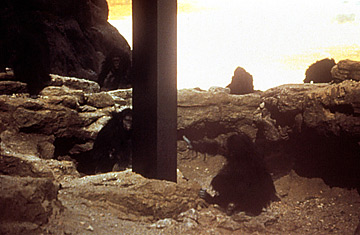
Director: Stanley Kubrick; Writers: Arthur C. Clarke, Stanley Kubrick
With Keir Dullea, Gary Lockwood, Douglas Rain
Warner Home Video
Available Oct. 23; List Price $26.98
What's happening at the beginning? What goes on at the end? Not many science fiction films encourage the audience to ask those questions, as 2001 did. An essay on man's destiny, the film was for some of its late-60s viewers a light show, a head trip, needing no earthbound explanations. But still, wouldn't it be nice to know? Forty years after the movie was made, viewers get some answers in a new, 43min. extra, 2001: The Making of a Myth, produced by Jamie Doran, directed by Paul Joyce and hosted by James Cameron.
In earth's pre-human history, the monolith appears; apes gather around it; one, called Moonwatcher, smashes a bone and forms it into a weapon, then throws it into the sky. Segue to a space ship, in what Clarke calls "a 3 million-year jump cut." In case you were thinking, "Huh?", the writer clarifies. "The Monolith was essentially a teaching machine," he says. "In fact our original idea was to have something with a transparent screen on which images would appear, which would teach the apes how to fight each other, how to maybe even make fire. But that was much too naive an idea. So eventually we just bypassed it with a device which we didn't explain — but they just touched it, and things happened to their brains, and they were transformed.... The bone goes up and becomes what is supposed to be a space bomb, though that isn't made clear."
The making-ofs round up a distinguished posse: Steven Spielberg; stars Keir Dullea and Gary Lockwood for the commentary; a bunch of the brilliant young technicians who, guided by the advice of NASA scientists, invented movie hyperspace; and George Lucas, to remind Star Wars fans that 2001 came first. "To see somebody actually do it, to make a visual film," Lucas says, "was hugely inspirational to me. If he could do it, I can do it." Except that what Lucas did was a very sophisticated kids' movie, with Saturday-matinee thrills and warp-drive plot thrust. What Kubrick made was an interspace art film. It had wonder as in awe and wonder as in head-scratching bafflement.
The technicians on the movie had to photo-mechanical wonder what Kubrick wanted. He wasn't always a lot of help. Christiane Kubrick, the director's wife, says he told his team: "Please draw me an image that doesn't remind me of anything in a color that doesn't exist." They had none of the digital gadgets that make short work of cosmos-imagining; all of the special effects were photo-mechanical, achieved within the camera. Sometimes nearly on it. Brian Johnson describes the floating-pen effect. They stuck the pen to a plate of glass and moved the plate slowly in front of the camera; the actress playing the stewardess then pulled the pen off the glass.
The 4-1/2 hrs. of extras, including a portfolio of Kubrick's Look photos and a long interview with director done in 1966, make this a must-have DVD. But the film's the thing — as ambitious as mid-century man's dream of space travel, as portentous and mysterious as what's out there. That mystery was a spur to Kubrick's intellect. As he said: "The most terrifying fact about the universe is not that it is hostile but that it is indifferent. If we can come to terms with this indifference and accept the challenges of life within the boundaries of death, our existence as a species can have genuine meaning and fulfillment. However vast the darkness, we must supply our own light."
A year after his space movie came out, man walked on the moon. But less than four years later, the manned exploration of other planet ceased. Kubrick didn't live to see humans chase the dreams and enigmas he put on the screen. Sadder still, the director died two years before 2001. Moviegoers were deprived of one of their headiest pleasures: anticipating the next Stanley Kubrick film.